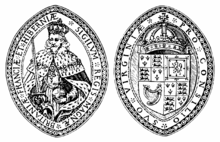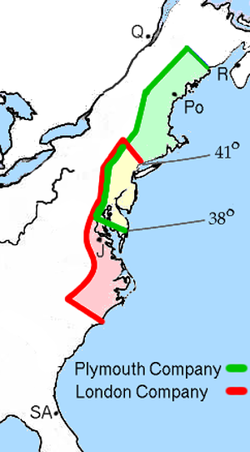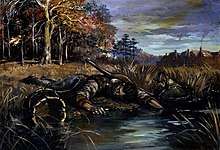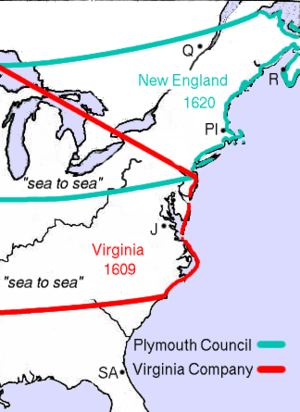London Company
The London Company (also called the Virginia Company of London) was an English joint-stock company established in 1606 by royal charter by King James I with the purpose of establishing colonial settlements in North America.[1]
 | |
| Public | |
| Industry | Company colonies |
| Fate | Dissolved |
| Predecessor | None |
| Successor | The Somers Isles Company (in Bermuda) |
| Founded | December 1606 |
| Defunct | 1624 |
| Headquarters | , |
Number of locations | Jamestown, Virginia, St. George's, Bermuda, Bermuda Hundred, Virginia, Henricus, Virginia, Charles City Point, Virginia |
Area served | Virginia, Bermuda, New England |
| Products | Cash crops, Tobacco, Timber |
The territory granted to the London Company included the eastern coast of America from the 34th parallel (Cape Fear) north to the 41st parallel (in Long Island Sound). As part of the Virginia Company and Colony, the London Company owned a large portion of Atlantic and Inland Canada. The company was permitted by its charter to establish a 100-square-mile (260 km2) settlement within this area. The portion of the company's territory north of the 38th parallel was shared with the Plymouth Company, with the stipulation that neither company found a colony within 100 miles (161 km) of each other.
The London Company made landfall on 26 April 1607, at the southern edge of the mouth of the Chesapeake Bay, which they named Cape Henry, near present-day Virginia Beach. Deciding to move the encampment, on 4 May 1607, they established the Jamestown Settlement on the James River about 40 miles (64 km) upstream from its mouth at the Chesapeake Bay. Later in 1607, the Plymouth Company established its Popham Colony in present-day Maine, but it was abandoned after about a year. By 1609, the Plymouth Company had dissolved. As a result, the charter for the London Company was adjusted with a new grant that extended from "sea to sea" of the previously-shared area between the 38th and 40th parallel. It was amended in 1612 to include the new territory of the Somers Isles (or Bermuda).
The London Company struggled financially, especially with labour shortages in its Virginia colony. Its profits improved after sweeter strains of tobacco than the native variety were cultivated and successfully exported from Virginia as a cash crop beginning in 1612. By 1619 a system of indentured service was fully developed in the colony;[2] the same year the home government passed a law that prohibited the commercial growing of tobacco in England.[3] In 1624, the company lost its charter, and Virginia became a royal colony.
A spin-off, The London Company of The Somers Isles (fully the Company of the City of London for the Plantacion of The Somers Isles, but generally referred to as The Somers Isles Company), operated until 1684.
History

In Renaissance England, wealthy merchants were eager to find investment opportunities, so they established several companies to trade in various parts of the world. Each company was made up of investors, known as "adventurers", who purchased shares of company stock. The Crown granted a charter to each company with a monopoly to explore, settle, or trade with a particular region of the world. Profits were shared among the investors according to the amount of stock that each owned. More than 6,300 Englishmen invested in joint-stock companies between 1585 and 1630, trading in Russia, Turkey, Africa, the East Indies, the Mediterranean, and North America.
Founding
Investors in the Virginia Company hoped to profit from the natural resources of the New World. In 1606 Captain Bartholomew Gosnold obtained of King James I a charter for two companies. The first, the Virginia Company of London (now known generally as the "London Company"), covered what are now Maryland, Virginia and Carolina, between Latitude 34° and Latitude 41° North. Gosnold's principal backers were Sir Thomas Gates, Sir George Somers, Edward Wingfield and Richard Hakluyt.[4][5]
The second company, the Plymouth Company of London (today known as the "Plymouth Company"), was empowered to settle as far as 45° North, encompassing what are present day Pennsylvania, New Jersey, New York, and New England.[6]
The Company paid all the costs of establishing each colony, and in return controlled all land and resources there, requiring all settlers to work for the Company.[7]
The first leader of the Virginia Company in England was its treasurer, Sir Thomas Smythe, who arranged the 1609 charter. He had been governor of the East India Company since 1603 and continued with one break until 1620.[8]
In an extensive publicity campaign, Wingfield, Gosnold and a few others, circulated pamphlets, plays, sermons and broadsides throughout England to raise interest in New World investments. Investors could buy stock individually or in groups. Almost 1,700 people purchased shares, including men of different occupations and classes, wealthy women, and representatives of institutions such as trade guilds, towns and cities. Proceedes from the sale of stock was used to help finance the costs of establishing overseas settlements, including paying for ships and supplies and recruiting and outfitng laborers. A single share of stock in the Virginia Company cost 12 pounds 10 shillings, the equivalent of more than six months' wages for an ordinary working man.[9][10][11]
The largest single investor was Thomas West, Lord de la Warre, who served as the first governor of Virginia between 1610 and 1618. (The English colonists named the Delaware River and Native American Lenape tribe for him.)
The business of the company was the settlement of the Virginia colony, supported by a labour force of voluntary transportees under the customary indenture system. In exchange for 7 years of labor for the company, the company provided passage, food, protection, and land ownership (if the worker survived).
First expedition
In December 1606, the Virginia Company's three ships, containing 105 men and boys as passengers and 39 crew members,[12]:601–602 set sail from Blackwall, London and made landfall on 26 April 1607 at the southern edge of the mouth of what they named the James River on the Chesapeake Bay. They named this shore as Cape Henry. They were attacked by Native Americans, and the settlers moved north. On 14 May 1607, these first settlers selected the site of Jamestown Island, further upriver and on the northern shore, as the place to build their fort.
In addition to survival, the early colonists were expected to make a profit for the owners of the Virginia Company. Although the settlers were disappointed that gold did not wash up on the beach and gems did not grow in the trees, they realised there was great potential for wealth of other kinds in their new home. Early industries, such as glass manufacture, pitch and tar production for naval stores, and beer and wine making took advantage of natural resources and the land's fertility. From the outset settlers thought that the abundance of timber would be the primary leg of the economy, as Britain's forests had long been felled. The seemingly inexhaustible supply of cheap American timber was to be the primary enabler of England's (and then Britain's) rise to maritime (merchant and naval) supremacy. However, the settlers could not devote as much time as the Virginia Company would have liked to developing commodity products for export. They were too busy trying to survive.

Within the three-sided fort erected on the banks of the James, the settlers quickly discovered that they were, first and foremost, employees of the Virginia Company of London, following instructions of the men appointed by the Company to rule them. In exchange, the laborers were armed, and received clothes and food from the common store. After seven years, they were to receive land of their own. The gentlemen, who provided their own armor and weapons, were to be paid in land, dividends or additional shares of stock.
Initially, the colonists were governed by a president and seven-member council selected by the King. Leadership problems quickly erupted. Jamestown's first two leaders coped with varying degrees of success with sickness, assaults by Native Americans, poor food and water supplies, and class strife. Many colonists were ill-prepared to carve out a new settlement on a frontier. When Captain John Smith became Virginia's third president, he proved the strong leader that the colony needed. Industry flourished and relations with Chief Powhatan's people improved.

Instructions for the Virginia Company
After so many failed colonizing attempts in the 16th Century such as the Roanoke Colony and with the ascension of King James to the throne of England on 24 March 1603 the effort to colonize was renewed, this time in the form of joint stock companies, which did not involve the public (King's) treasury thus from a Royal perspective a risk-free endeavor. Although a profit-driven enterprise, the King was motivated by international rivalry and the propagation of religion, and the individuals who undertook the risk of venturing to the new world were motivated by a chance to improve their economic and social standing.
Thus King James awarded a patent to a group of investors which included detailed instructions for everything from where to place watchmen and with how many, to where to plant. It instructed Christopher Newport, captain of the Susan Constant, and Bartholomew Gosnold, captain of the Godspeed and leader of the expedition of three ships, on their duties upon reaching the land they named Virginia. There were no instructions for administration or governance.[13]
The Charter of 1606
The First Virginia Charter established provisions for governance of the colony. It was to be governed by a colonial council, which proved ineffective. A governor, Lord De La Warr, was dispatched in 1610 to provide firmer governance of the colony. The council back in London whose directives and interests Lord De La Warr represented was composed of knights, gentlemen and merchants who had invested in the company. This charter also limited the jurisdiction of the Virginia company of London to 100 miles from the seaboard and from 38 degrees to 45 degrees latitude north.[14]
Charter of 1609

In 1609, the Virginia Company received its Second Charter, which allowed the Company to choose its new governor from amongst its shareholders. Investment boomed as the Company launched an intensive recruitment campaign. Over 600 colonists set sail for Virginia between March 1608 and March 1609.[15]
Sir Thomas Gates, Virginia's deputy governor, bound for the colony in the Third Supply aboard the Sea Venture, was shipwrecked in Bermuda, along with the Admiral of the Company, Sir George Somers, Captain Newport, and 147 other settlers and seamen. When Gates finally arrived to take up his new post in 1610, with most of the survivors of the Sea Venture (on two new ships built in Bermuda, the Deliverance and the Patience), he found that only 60 of the original 214 colonists had survived the infamous "Starving Time" of 1609–1610.[16] Most of these were dying or ill. Despite the abundance of food which Gates' expedition brought from Bermuda (which had necessitated the building of two ships), it was clear the colony was not yet self-sufficient and could not survive.
The survivors of Jamestown were taken aboard the Deliverance and the Patience, and the colony was abandoned. Gates intended to transport all the settlers back to England, but the fortuitous arrival of another relief fleet, bearing Governor Lord De la Warre, granted Jamestown a reprieve. All the settlers were put ashore again, and Sir George Somers returned to Bermuda aboard the Patience to obtain more food. (Somers died there, and his nephew, Matthew Somers, the captain of the Patience, sailed the vessel to Lyme Regis in England, instead, to claim his inheritance).
Charter of 1612
The third Virginia Charter or Charter of 1612, was essentially the same as the Charter of 1609, with the difference being territorial jurisdiction, expanding it to the Atlantic Islands like Bermuda and from “sea to sea”.[17]
The "Great Charter"
This was an ordinance and constitution that proceeded from a set of instructions issued in 1618 to the governor and the Council of Virginia known as An Ordinance and Constitution of the Virginia Company in England 24 July 1621.[18] This document replaced military law with common law, and provided for land ownership for settlers living in the colony.[19]:283 It is also of great significance for it provides governance independent of the Crown. An assembly took place in a church composed of Governor Sir George Yeardley and 22 select men representing seven regions. They then organized into a legislative body, establishing a precedent for self-governance, a pivotal point in American history.[20]
Collapse and dissolution
After 1620, with growing demand for tobacco on the continent, the Company arranged to sell Virginia tobacco in the Netherlands, but the next year and despite company pleas to maintain the privilege of freedom of trade, the Privy Council forbade the export of any product of Virginia to a foreign country until the commodities had been landed in England, and English duties had been paid.[3] By 1621, the Company was in trouble; unpaid dividends and increased use of lotteries had made future investors wary. The Company debt was now over £9,000. Worried Virginians were hardly reassured by the advice of pragmatic Treasurer Sandys, who warned that the Company "cannot wish you to rely on anything but yourselves." In March 1622, the Company's and the colony's situation went from dire to disastrous when, during the Indian massacre of 1622, the Powhatan confederacy killed one-quarter of the European population of the Virginia colony.
When the Crown and company officials proposed a fourth charter, severely reducing the Company's ability to make decisions in the governing of Virginia, subscribers rejected it. King James I forthwith changed the status of Virginia in 1624, taking control of it as a royal colony to be administered by a governor appointed by the King. The government's colonial policy of export restrictions however, did not change. The Crown approved the election of a Virginia Assembly in 1627. This form of government, with governor and assembly, would oversee the colony of Virginia until 1776, excepting only the years of the English Commonwealth.
Bermuda had been separated from the Virginia Company in 1614, when the Crown briefly took over its administration. In 1615, the shareholders of the Virginia Company created a new company, the Somers Isles Company, which continued to operate Bermuda. It was subsequently, also known officially as The Somers Isles (for the Admiral of the Virginia Company, Sir George Somers) until being dissolved in 1684 and made a royal colony. Meetings were held at town hall to discuss the distribution of the tobacco.
Native American relationships
The instructions issued to Sir Thomas Gates, on 20 November 1608, called for a forcible conversion of Native Americans to Anglicanism and their subordination to the colonial administration. The records of the company record a discussion during one of its first meetings about publishing a justification of their business enterprise methods to "give adventurers, a clearness and satisfaction", a public debate where Catholics and neutrals might attack them. Whereas Catholic arguments would be in support of Spanish legal claims to the New World under the Treaty of Tordesillas, it was feared that the neutral "pen-adversaries" might "cast scruples into our conscience" by "criticising the lawfulness of the plantation." It was decided to forego such a publication of a justification.
In 1608, Sir Edward Coke, in his capacity as Lord Chief Justice, offered a ruling in Calvin's Case that went beyond the issue at hand: whether a Scotsman could seek justice at an English Court. Coke distinguished between aliens from nations at war with England and friendly aliens, those from nations in league with England. Friendly aliens could have recourse to English courts. But he also ruled that with "all infidels" (i.e. those from non-Christian nations), there could be no peace, and a state of perpetual hostility would exist between them and Christians.[21]
In 1609, the company issued instructions to settlers to kidnap Native American children so as to educate them with English values and religion. These instructions also sanctioned attacking the Iniocasoockes, the cultural leaders of the local Powhatans. Only after Thomas West, 3rd Baron De La Warr arrived in 1610, was the Company able to commence a war against the Powhatan with the First Anglo-Powhatan War. De La Warr was replaced by Sir Thomas Dale, who continued the war, which continued until a truce was made with the marriage of Pocahontas to John Rolfe in 1614.
The military offensive was accompanied by a propaganda war: Alderman Robert Johnson published Nova Britannia, in 1609, which compared Native Americans to wild animals--"heardes of deere in a forest". While it did portray the Powhatan as peace-loving, it threatened to deal with any who resisted conversion to Anglicanism as enemies of their country. (Johnson was the son-in-law of Sir Thomas Smythe, treasurer of the Company in London and leader of its "court" faction.)
The Company began to turn a profit after 1612, when planting a couple of new varieties of tobacco yielded a product that appealed more to English tastes than the native tobacco. Tobacco became the commodity crop of the colony, and settlers were urged to cultivate more. The colony struggled with labor shortages as mortality was high.
In 1622, the Second Anglo-Powhatan War erupted. Its origins are disputed. English apologists for the company say that Opchanacanough initiated the war. Robert Williams, a 21st-century Native American law professor, argues that Opchanacanough had secured concessions from Governor Yeardley which the company would not accept. Thus, Opchanacanough's attack, on 18 April 1622, may have been a pre-emptive attempt to defeat the colony before reinforcements arrived.[21] :213–217
In about a day, the Powhatan killed 350 of 1,240 colonists, destroying some outlying settlements. The Virginia Company quickly published an account of this attack. It was steeped in Calvinist theology of the time: the massacre was the work of Providence in that it was justification for the destruction of the Powhatan, and building English settlements over their former towns. New orders from the London Company directed a "perpetual war without peace or truce" "to root out from being any longer a people, so cursed a nation, ungrateful to all benefitte, and incapable of all goodnesses."[22] Within two years, the Crown took over the territory in 1624 as a royal colony.
See also
- Richard Hakluyt, a director of the company
- Jamestown, Virginia
- List of trading companies
- Somers Isles Company
- Sir Edwin Sandys
- Thomas Graves
- Nicholas Ferrar
- John Ferrar
- Samuel Argall
- Sir John Harvey
- Samuel Jordan
- William Farrar
References
- Charles Wankel (16 June 2009). Encyclopedia of business in today's world. SAGE Publications. p. 333. ISBN 978-1-4129-6427-2. Retrieved 8 April 2011.
- Karl Frederick Geiser, Redemptioners and indentured servants in the colony and commonwealth of Pennsylvania, p.5. Supplement to the Yale Review, Vol. X, No. 2, August, 1901.
- Chapter III - The Commercial Policy of England Toward the American Colonies: the Acts of Trade, p.37 in Emory R. Johnson, T. W. Van Metre, G. G. Huebner, D. S. Hanchett, History of Domestic and Foreign Commerce of the United States - Vol. 1, Carnegie Institution of Washington, 1915. Retrieved 2016-01-15 – via Questia (subscription required)
- Brown, Alexander (1890). The Genesis of the United States. https://archive.org/details/TheGenesisOfTheUnitedStatesV1/page/n105: Houghton, Mifflin and Company. pp. 48–85. ISBN 978-0788401046.CS1 maint: location (link)
- "The First Charter of Virginia: 1606". American History: Revolution to Reconstruction. Retrieved Mar 29, 2019.
- Anderson, Adam (1764). An Historical and Chronological Deduction of the Origin of Commerce. 1. London : Printed for A. Millar, J. and R. Tonson ... p. 471.
- "How the Virginia Company of London Governed the Colony of Virginia". Virginia Places. Retrieved Mar 29, 2019.
- "Sir Thomas Smythe (ca. 1558–1625)". Encyclopedia Virginia. Retrieved Mar 29, 2019.
- "The Virginia Company of London" (PDF). History is Fun. Retrieved Mar 29, 2019.
- "The Virginia Companies Public Relations Campaign 1612". Library of Congress. Retrieved Mar 29, 2019.
- "Records of the Virginia Company". Virtual Jamestown.
- Bernhard, Virginia (1992). ""Men, Women and Children" at Jamestown: Population and Gender in Early Virginia, 1607-1610". The Journal of Southern History. 58 (4): 599–618. doi:10.2307/2210786. JSTOR 2210786.
- "Instructions for the Virginia Colony 1606". American History Revoluion to Reconstruction and Beyond.
- "First Virginia Company". American History Revolution to Reconstruction.
- "Charter of 1609". American History Revolution to Reconstruction.
- "Archived copy". Archived from the original on 2009-04-16. Retrieved 2013-10-26.CS1 maint: archived copy as title (link) Association for the Preservation of Virginia Antiquities: Jamestown History
- "The Third Virginia Charter". American History Revolution to Reconstruction and Beyond.
- Bemiss, Samuel M., ed. (1957). ""Virginia Company, Instructions to Governor Yeardley"(Sometimes called "The Great Charter")". The Three Charters of the Virginia Company of London with Seven Related Documents. Williamsburg, VA: Virginia 350th Anniversary Celebration Corporation.
- Kukla, Jon (1985). "Order and Chaos in Early America: Political and Social Stability in Pre-Restoration Virginia". The American Historical Review. 90 (2): 275–299. doi:10.2307/1852667. JSTOR 1852667.
- "An Ordinance and Constitution of the Virginia Company in England 24 July 1621". American History from Revolution to Reconstruction and Beyond.
- Williams, Robert A. (1990). "The English Conquest of America". The American Indian in Western Legal Thought. Oxford, England: Oxford University Press. pp. 193–232. ISBN 978-0195050226. OL 2058188M.
- Bryant, William Cullen; Gay, Sidney Howard (1876). A Popular History of the United States. 1. London, England: Sampson Lowe, Marston, Searle & Rivington. p. 481.
Further reading
- The Three Charters of the Virginia Company of London edited and introduction by Samuel M. Bemiss, published by Virginia's 350th Anniversary Celebration Corp, 1957, Williamsburg, Virginia. ISBN 0-8063-5088-1
- Dissolution of the Virginia Company: The Failure of a Colonial Experiment by Wesley Frank Craven, published by Oxford University Press, 1932, New York
- The Virginia Company of London, 1606-1624, by Wesley Frank Craven, published by University Press of Virginia, 1957, Charlottesville, Virginia. ISBN 0-8063-4555-1
- The First Seventeen Years: Virginia, 1607-1624, by Charles E. Hatch, Jr. ISBN 0-8063-4739-2
- History of the Virginia Company of London with Letters to and from the First Colony Never Before Printed, by Edward D. Neill, originally published by Joel Munsell, 1869, Albany, New York, reprinted by Brookhaven Press ISBN 1-58103-401-6
- Love and Hate in Jamestown: John Smith, Pocahontas, and the Heart of A New Nation, by David A. Price, published by Alfred A. Knopf, 2003, New York
External links
- London Company nowadays (founded in 1994, not related in any way other than the name)
- List of original settlers Jamestown Rediscovery
- 1606 Charter of the Virginia Company of London
- National Park Service brief
- Daily Republican: The Virginia Company
- Library of Congress images of manuscript and printed editions of the Records of the Virginia Company of London
- The Anglo-Powhatan Wars
- Richmond Times Dispatch: Virginia's roots reach to Bermuda
- The Virginia Company of London, 1606-1624 - Free ebook from manybooks.net